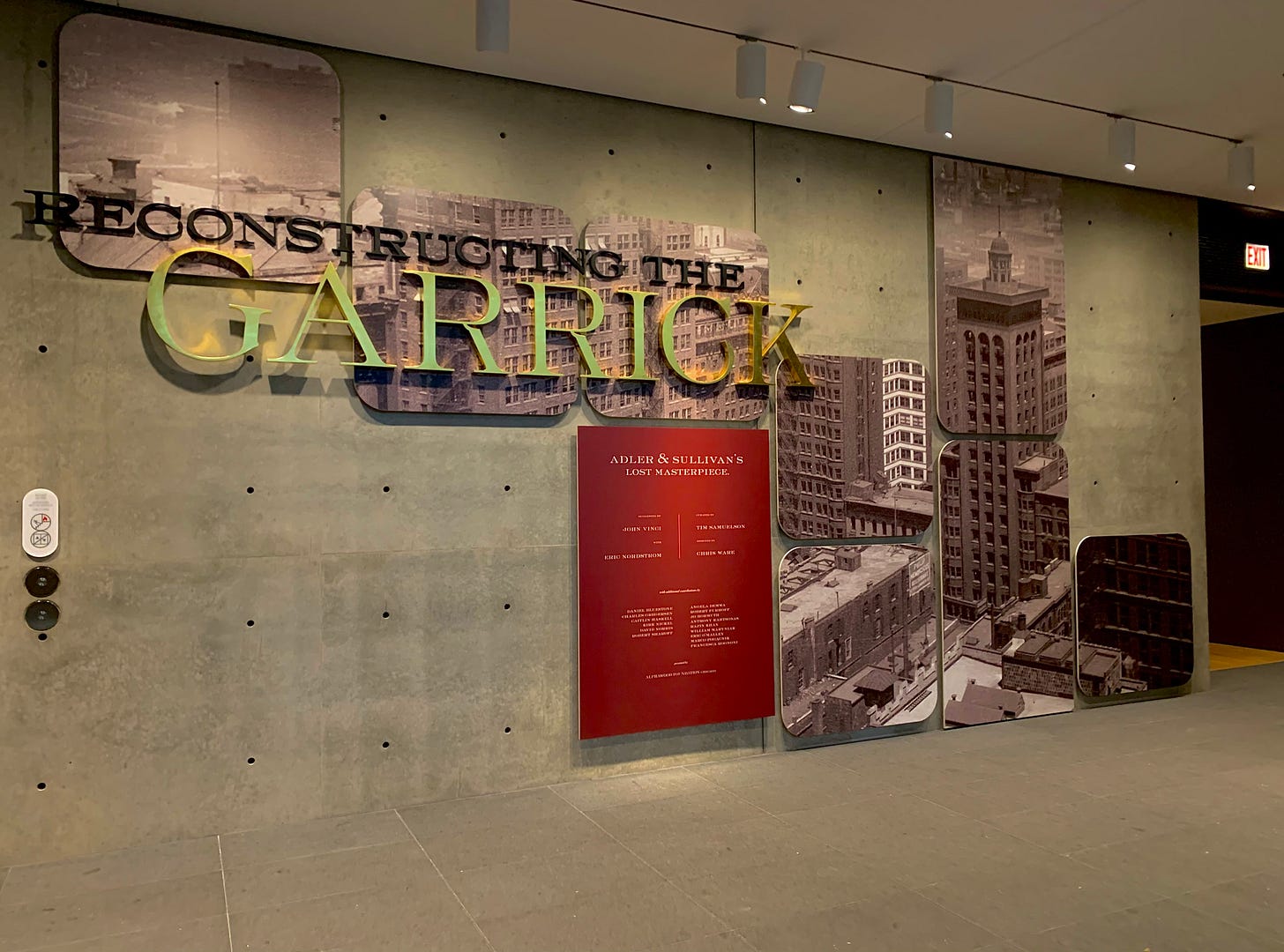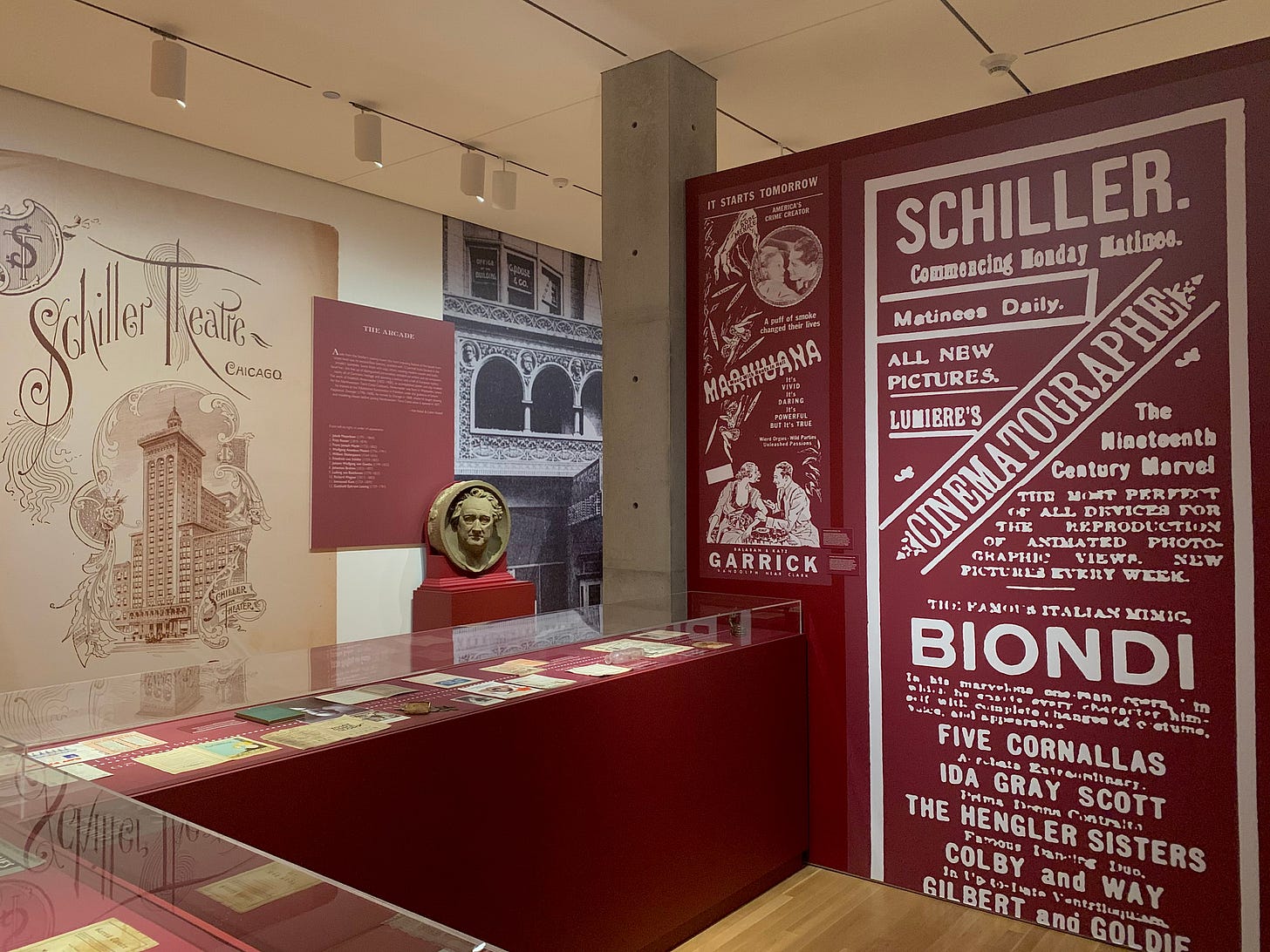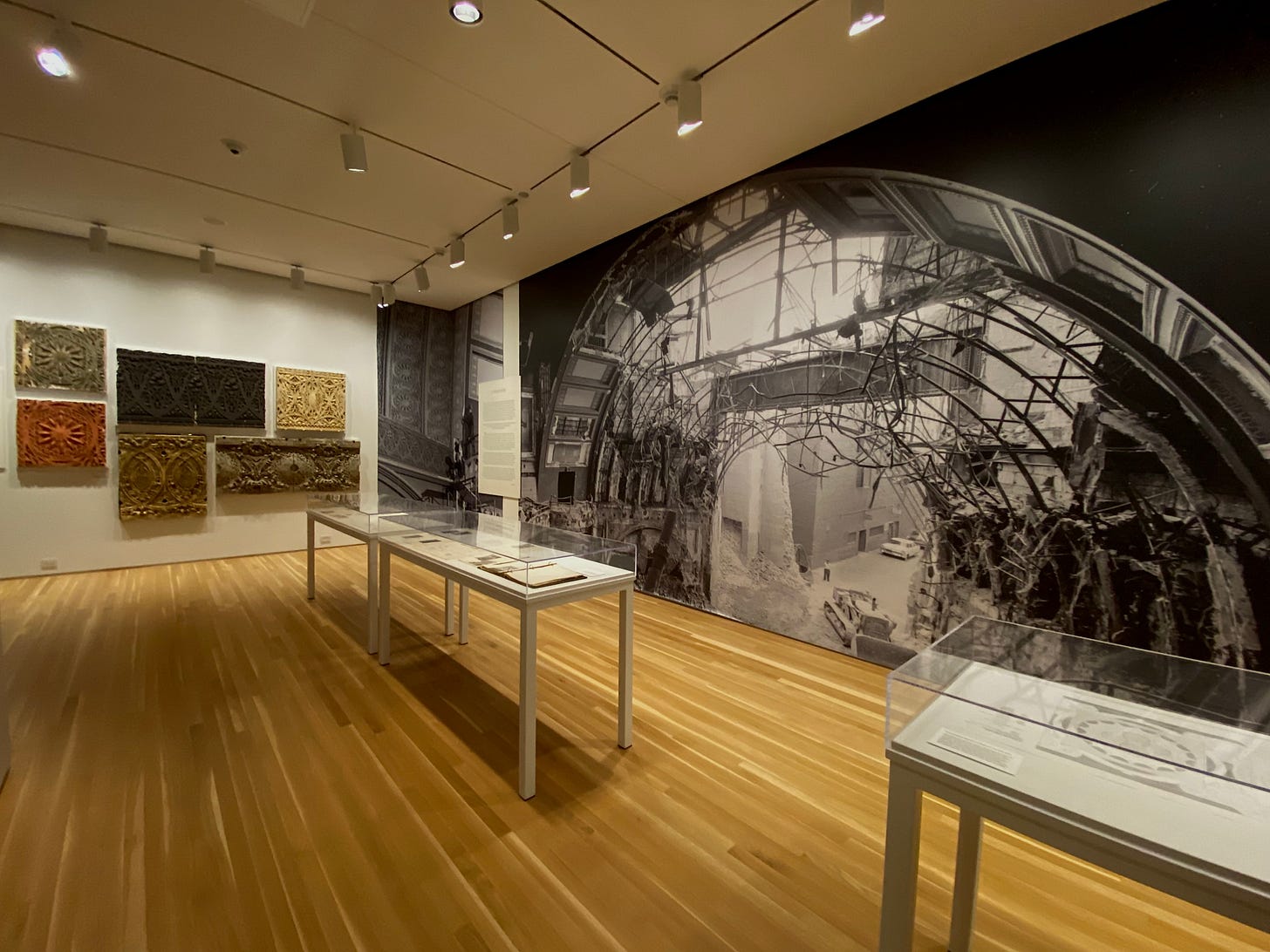This weekend I finally went to Wrightwood 659 to see Romanticism to Ruin, an exhibit about two lost works by Louis Sullivan and Frank Lloyd Wright. It was my first time inside this building within a building, which opened in 2018. Pritzker Prize-winning Japanese architect Tadao Ando incorporated the shell of a 1920s apartment building, transforming the space into a multi-level art and architecture gallery. The mask-like facade perfectly blends in with the residential neighborhood street while the interior is a beautiful textural combination of Chicago Common brick and exposed concrete. Ando’s dramatic design is the perfect venue to host what proves to be a visually striking exhibition with its 3D architectural models and digital recreations of Sullivan’s Garrick Theater in Chicago and Wright’s Larkin Building in Buffalo.
As a fan of Tim Samuelson and Chris Ware’s previous exhibits, I was excited to see the Louis Sullivan section, Reconstructing the Garrick, as I already had the two related books (I wrote a review about one of them) and co-curator Chris Ware had even invited me to its opening, which I unfortunately could not attend. No one knows Adler & Sullivan’s work better than Tim Samuelson and John Vinci, who assisted Richard Nickel on salvaging much of what was on display in this exhibit. Their expertise and attention to detail is what made the show so rewarding for someone like me aka number one fan of Louis Sullivan. They always do such a good job at putting the ornament into context by placing the pieces against old black and white photos. As someone who works at an Adler & Sullivan-designed building, I couldn’t help but notice how similar the colors of the surviving mosaic floor fragments of the Garrick were to the fireplace of my house museum.
Beyond the salvaged architectural ornament and archival photographs, what stood out to me was the historical ephemera related to the tenants and performers of the multi-purpose building, which was Chicago’s tallest at the time of its construction between 1891-92. Originally known as the Schiller, during its seventy-year existence the Garrick Theater was also an office building that was home to everyone from the Illinois State Brewers Association to various architects like Frank Lloyd Wright and Harry Bergen Wheelock. The Chicago Board of Education held regular meetings in the 13th floor meeting room in the 1890s. They were the ones responsible for painting over the “original complexly colored decorative scheme” of what originally belonged to the Schiller Club. It was first nail in the coffin that sealed the building’s fate.
It’s somewhat ironic that after Wright was fired by Sullivan in 1893, he rented offices with friend Cecil S. Corwin on the 15th floor of the Sullivan-designed building. With an office four floors down, Harry Wheelock was the adopted son of Otis L. Wheelock, best known for being one of Chicago’s first practicing architects. The younger Wheelock was clearly influenced by Sullivan as his work, such as the now demolished Western Methodist Book Exchange Building, had Sullivanesque ornament done by Northwestern Terra Cotta Company modeler Kristian Schneider, who executed nearly all of Sullivan’s designs.
There were some well-known people are who took the Garrick stage either for political or social causes like Jane Addams, Eugene V. Debs, and Clarence Darrow or for pure entertainment value like Sophie Tucker, Ethel Waters, or Mae West (although her 1930 performance of Sex had a political bent). The Garrick’s architectural design was certainly an achievement but looking through all the historical moments that took place there makes its demolition even more heart-breaking. Like the Joni Mitchell song “Big Yellow Taxi” the Garrick was demolished for a parking garage in 1961, but only after preservationist Richard Nickel and others tried in vain to save it. Not only did he salvage hundreds of pieces from the building which he recorded in “almost military precision” in a workbook, but he took extensive notes, diagrams, and photographs. After reading so much about him over the years, it was cool to see Nickel’s personal loose leaf binder, the various letters he wrote to people as he attempted to save other Sullivan-designed buildings, and his only surviving camera.
The highlight of the show was Razin Khan’s animation of the Garrick, projected on a wall in a theater-like setting at the end of a long hallway displaying a recreation of the banquet hall frieze. Attendees sat on benches, many of them staying for its entire length as the building was shown from all angles-it even included the street car that once ran down Randolph Street-and then the visualization slowly panned through all parts of the remarkable interior. If you hadn’t already felt anger towards the tragic and unnecessary demolition of the Garrick, watching the film really drives it home. To see the Garrick living and breathing, even in animation form, left me feeling depressed and bitter, knowing that Chicago is still tearing down its architectural treasures.
Even though it was a two-part exhibition spread over three and a half levels, the Wright section seemed more like an afterthought. It didn’t matter to me that Reimagining the Larkin was not as substantial as the Garrick part because after all I’m a number one Louis Sullivan fan. Wright’s life and career has been exhaustively scrutinized for decades so I was perfectly happy to see the the mentor finally overshadow his student for once. It’s about time! If I found anything interesting, it was probably the various items produced by the Larkin Company beyond its soap.
Compared to the Garrick animation, I barely paid attention to the video of Wright’s Larkin Building, which was shown on a wall-mounted flat screen in a dead-end corner of the exhibit. I don’t think most visitors even saw the end of Reimagining the Larkin as it’s oddly placed in the gallery’s rooftop terrace away from the main section. But it really didn’t matter. I was exhausted after spending almost two hours walking through Wrightwood 659. As someone who once studied and worked at a number of museums and art galleries, the Romanticism to Ruin exhibit was everything I could possibly want in a display like this one, from the building itself to the beautifully designed graphics to the meticulous information. If you are interested in Adler & Sullivan, Chicago history and architecture, and/or Richard Nickel and historic preservation, please go see this exhibit if you haven’t already gone. It runs until December 18th.

















Is there anyway to see the digital walk-through? Or better yet - download the files in VR for oculus?